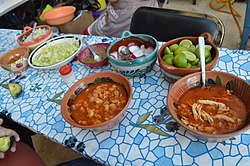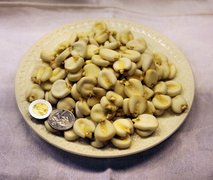Pozole
 Pozole verde at a restaurant in Mexico City (2018) | |
| Type | Soup |
|---|---|
| Place of origin | Mexico |
| Region or state | Central Mexico |
| Created by | Nahuas |
| Serving temperature | Hot |
| Main ingredients | Hominy, meat (usually pork or chicken), chile peppers, seasonings |
| Variations | Blanco, Verde, Rojo |
Pozole (Spanish pronunciation: [po'sole]; from Nahuatl languages: pozoll , meaning "Cacahuazintle" a variety of Corn or Maize), is a traditional soup or stew from Mexican cuisine. It is made from hominy with meat (typically pork, but possibly chicken), and can be seasoned and garnished with shredded lettuce or cabbage, chile peppers, onion, garlic, radishes, avocado, salsa or limes. Known in Mesoamerica since the pre-Columbian era, today the stew is common across Mexico and neighboring countries, and is served both as a day-to-day meal and as a festive dish.
Description[]
Pozole can be prepared in many ways, but all variations include a base of cooked hominy in broth. Typically pork, or sometimes chicken, is included in the base. Vegetarian recipes substitute beans for the meat.
The three main types of pozole are blanco/white,[1] verde/green and rojo/red. White pozole is the preparation without any additional green or red sauce. Green pozole adds a rich sauce based on green ingredients, possibly including tomatillos, epazote, cilantro, jalapeños, or pepitas. Red pozole is made without the green sauce, instead adding a red sauce made from one or more chiles, such as guajillo, piquin, or ancho.
Pozole is commonly served accompanied by a wide variety of condiments. Common condiments include chopped onion, shredded cabbage, sliced radish, avocado, limes, oregano, tostadas, chicharrón, and chiles.[2]
Serving[]

Pozole is a typical dish in various states such as Nayarit, Sinaloa, Michoacán, Guerrero, Zacatecas, Jalisco, and Morelos. Pozole is served in Mexican restaurants worldwide. It is also popular (under the older spelling posole) in the cuisine of New Mexico where it was a common dish among the Pueblo Indians residing along the Rio Grande.[3][4]
Pozole is also a festive dish. In Mexico, pozole is typically served on New Year's Eve to celebrate the new year.[5][6] Pozole is frequently served as a celebratory dish throughout Mexico and in Mexican communities outside Mexico. Other occasions for serving pozole include Mexican Independence Day, birthdays, Christmas and other holidays.[7]
History[]

Pozole was mentioned in the 16th century Florentine Codex by Bernardino de Sahagún.[9] Since maize was a sacred plant for the Aztecs and other inhabitants of Mesoamerica, pozole was made to be consumed on special occasions.
According to research by the Instituto Nacional de Antropología e Historia (National Institute of Anthropology and History) and the Universidad Nacional Autónoma de México, on these special occasions, the meat used in the pozole was human. After the prisoners were killed by having their hearts torn out in a ritual sacrifice, the rest of the body was chopped and cooked with maize, and the resulting meal was shared among the whole community as an act of religious communion. After the Conquest, when cannibalism was banned, pork became the staple meat as it "tasted very similar" [to human flesh], according to Bernardino de Sahagún.[10][11]
Gallery[]
White Pozole
Cooked hominy

Dried hominy can be used for pozole, but it must be soaked and cooked.

Pozole topped with sliced avocado
Green pozole, cooked in Guerrero State fashion
Green pozole, with condiments, served in Zihuatanejo (Guerrero)
Red pozole, served in Mexico City
A plate of condiments for pozole
See also[]
- Fricasé
- List of maize dishes
- List of Mexican dishes
- List of soups
- List of stews
- Menudo (soup) – a similar dish made with tripe
- Mexican cuisine
References[]
- ^ Cookpad: Pozole Blanco
- ^ Bauer, Elise (8 October 2011). "Authentic Pozole Rojo (Red Posole) Recipe". Simply Recipes. Retrieved 13 May 2019.
- ^ Cocking, Lauren (12 February 2017). "A Brief History of Pozole, Mexico's Take on Traditional Stew". Culture Trip. Retrieved 13 May 2019.
- ^ Butel, Jane (11 December 1994). "Sacred Stew : Posole, a Native American corn dish, is served at pueblo festivals, but it can also be sampled in restaurants around Albuquerque". latimes.com. Retrieved 13 May 2019.
- ^ Anonymous; Seibert, Sandra; Anonymous; Pharo, Christine; Anonymous; Morethanbeefandtaters; Anonymous; G., Pauline; M., Monica (16 November 2016). "Posole Rojo". Food Network. Retrieved 13 May 2019.
- ^ "Red Posole with Pork". Epicurious. 30 May 2017. Retrieved 13 May 2019.
- ^ "Mexican Pozole". Mexico. Retrieved 13 May 2019.
- ^ Pozolli. (n.d.). Nahuatl dictionary. Retrieved 28 August 2012, from http://whp.uoregon.edu/dictionaries/nahuatl/index.lasso
- ^ Bernardino de Sahagún, Florentine Codex: General History of the Things of New Spain (Translation of and Introduction to Historia General de Las Cosas de La Nueva España; 12 Volumes in 13 Books ), trans. Charles E. Dibble and Arthur J. O Anderson (Salt Lake City: University of Utah Press, 1950–1982). Images are taken from Fray Bernardino de Sahagún, The Florentine Codex. Complete digital facsimile edition on 16 DVDs. Tempe, Arizona: Bilingual Press, 2009. Reproduced with permission from Arizona State University Hispanic Research Center.
- ^ Mexico On My Plate: Red Pozole and It’s [sic] History
- ^ Mexico, Surviving (12 July 2016). "Aztec cannibalism". Surviving Mexico. Retrieved 13 May 2019.
- Maize dishes
- Mesoamerican cuisine
- Mexican soups
- Mexican stews


















